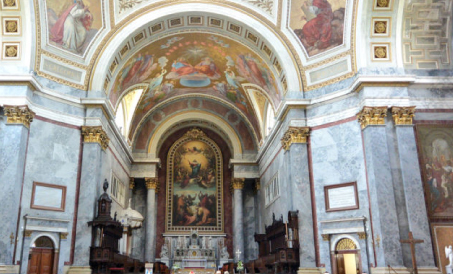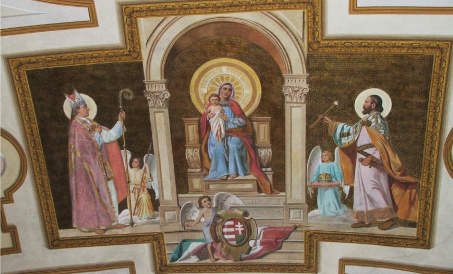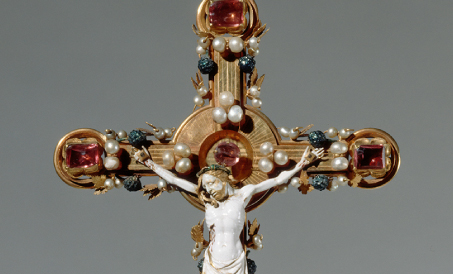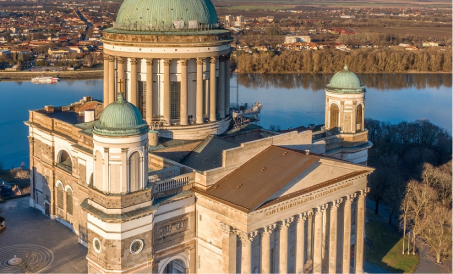The core of medieval Esztergom, consisting of the Castle, the Royal City and the Water Town, is the Castle, which was already the royal seat of Prince Géza with some fortified residence and a chapel named after St. Stephen the First Martyr. St. Stephen was born here, baptized and crowned here, and founded the archdiocese here. St. Stephen, handing over the residence to the archdiocese, built a new royal palace on the southern tip of the hill, and in the middle of the hill a church dedicated to the Blessed Virgin and St. Adalbert. Next to its vestibule is the monastery (chapter house), and to the north is the chapel of St. Stephen the Martyr, which later became the archbishop's private church, and from 1391 the church of St. Stephen's provostship and condominium. Around 1180 a fire destroyed the Castle. The royal palace was restored by King III. Bela, the Church of St. Adalbert is restored with royal help by Archbishop Job.
In 1256 IV. Bela gave the whole Castle to the archbishops. From then on, its protection and maintenance was the concern and duty of archbishops. The Cathedral of St. Adalbert was rebuilt by Archbishop Csanád Telegdi, later by Archbishop Dénes Szécsi, who consecrated it in 1453 with the dual titles of Virgin Mary and Saint Adalbert. The great cathedral with three naves, 30 fathoms long, 10 fathoms wide, adorned with rich artistic workmanship, with three towers, interior and exterior chapels, with 12 altars, is rightly and admirably referred to as "ecclesia magnifica." In addition to governing the extensive archbishopric province, pastoral care is also carried out in the Castle. The Church of St. Stephen the Martyr is the parish church of the people settled from the Royal City to the Castle from IV. Bela in 1249. However, the people moved back to te city in 1256. For the pastoral functions of the castle people, the Holy Cross altar of the Cathedral of St. Adalbert is used. The Statute of the Chapter of Esztergom from the year of 1397 summarises the duty of the Rector of the Holy Cross altar canon as follows: „Ad rectorem pertinet cura animarum et ministratio sacramenti omnium commorantium in castro, capitulo et in scholis Strigoniensibus.” Mihály Kesztölczi, canon (1469-1499), commissioned the St. Jerome Chapel in the north tower of the cathedral and established a foundation for a permanent confessional service there.
After the Battle of Mohács, in which Primate László Szalkay also falls, the chapter moves to Bratislava and then to Trnava to escape the Turks. The cathedral was damaged already during the siege of 1543. After capturing the Castle, the Turks demolish the apse for military reasons, crush its inner ornaments, and use it as a jami. In 1594, during the battle to retake the Castle, it was severely damaged by the explosion of gunpowder stored in it. At the final liberation the cathedral is in ruins. Only the Annuntiatio Chapel of Archbishop Tamás Bakócz, built between 1506 and 1511, escaped destruction. After the reconquest, the Te Deum was heard here, and the priests of the garrison performed their services here.
Maria Theresia returned the Castle to the archdiocese in 1761. From then on, the parish priests of Watertown are entrusted with the spiritual care of the inhabitants of the Castle. Between 1768 and 1770 Maria Theresia built a Baroque church in the middle of the Castle in honor of St. Stephen. Already at this construction, the ruins of the former, famous St. Adalbert's Cathedral are running out. They disappeared permanently under Prince-Primates Ferenc Barkóczy (1761–65) and then Sándor Rudnay (1819–31) to make way for the construction of the new church, today's Primate Basilica. The foundation stone of the huge building (5660 m2) was laid in 1822 by Prince-Primate Sándor Rudnay. It was consecrated on 31 August 1856 by Prince-Primate János Scitovszky in honor of the Holy Virgin and Saint Adalbert, bishop and martyr. Since 1856, the parish priest of the cathedral has been a member of the chapter.
The sanctuary of parish functions is the Bakócz Chapel, rebuilt intact in the Basilica, whose ancient altarpiece attracted pilgrims for a long time. The parish has kept its registers since 1822. Among the renovation works of recent years, the restoration of the roof structure above the eastern nave after fire damage stands out. It is a monument with registration number 2350.
The statue of Mary near the southern tower of the Basilica was commissioned by the wife of city commander Ferenc Kuckländer in 1710 based on the Madonna of Altötting.
The chapel of the Simor Priestly Home (Dobozi M. u. 12.) in the parish is used by the residents of the Home.
The list of the Priests
Between 1717 and 1725 German-speaking priests were commissioned to provide pastoral care for the Castle Hill, the garrison. Later on, the Castle Hill is entrusted to the Jesuit community of Watertown – during this period the housekeepers are also castle parish priests:
| 1725– | István Kolb SJ |
| 1732– | Lipót Hanstadt SJ |
| 1739– | József Peüchl SJ |
| 1743– | Ignác Gruber SJ |
| 1748– | József Wolfsegger SJ |
| 1752– | Mihály Frigeri SJ |
| 1754– | Ignác Kelecsényi SJ |
| 1755– | György Ferdinkó SJ |
| 1759– | János Nagy SJ |
| 1761– | Ádám Kereskényi SJ |
During this period, the Bakócz Chapel also had independent remunerated priests, but we only know the names of a few of them:
| In 1733 | Ferenc Langecker |
| In 1734 | Ferenc Joachim |
| In 1758 | György Széles |
From 1761 the Castle Hill belonged to the Watertown Parish. The priests of the Bakócz Chapel, the garrison church built by Maria Theresa and the basilica under construction were entrusted with the pastoral care of the area, who held the status of assistant pastor next to the parish priest of Watertown:
| 1761– | György Széles |
| 1773– | György Ujváry |
| 1782– | Antal Horváth |
| 1792– | György Chalupkay |
| 1793– | Ferenc Nagy |
| 1798– | György Balluch |
| 1810– | István Végh |
| 1843– | Alajos Somogyi |
| 1849– | Józse fÜrge |
The Cathedral Parish was a completely independent unit since 1856. From then on, its parish priests came from the ranks of the Cathedral Chapter:
| 1856– | Tódor Ordódy |
| 1863– | István Lipovniczky |
| 1866– | Antal Szántófy |
| 1880– | József Krotky |
| 1894– | Dr. János Csernoch |
| 1909– | József Brühl |
| 1916– | Károly Kanter |
| 1921– | Dr. Antal Lepold |
| 1932– | Kálmán Jeszenszky |
| 1947– | Dr. József Tiefenthaler |
| 1951– | István Thaler |
| 1965- | István Vajay |
| 1974– | Tibor Kovács |
| 2007– | Dr. János Németh |
Since 1st August , 2020, dr. Csaba Török has been the responsible pastor of the Cathedral in the capacity of administratot of the parish.
From August 1, 2021, the Cathedral Parish serve St. Ignatius of Loyola Parish in Esztergom-Watertown. In this way, after 165 years, the historical unity of the two parishes was restored. From the same day – after 36 years – the Cathedral Parish has had a chaplain again, in the person of Father Imre Tóth and later Father Árpád Bársony.
Sources:
Series parochiarum et parochorum Archi-Dioecesis Strigoniensis: ab antiquissimis temporibus usque annum MDCCCXCIV / collegit et notis illustravit Ludovicus Némethy. - [Esztergom] Strigonii : [s.n.], 1894. available online on the website of the Esztergom Cathedral Library.
Directory and Yearbook of the Archdiocese of Esztergom-Budapest : Schematismus statusque Archidiocesis Strigoniensis-Budapestinensis anno Domini MMVII /edited by Balázs Mig, Gabriella Szászvári, János Csaba Tóth, Judit Zubreczki. - Budapest : 2007 The parish section is available online on the website of the Archdiocese of Esztergom-Budapest.







